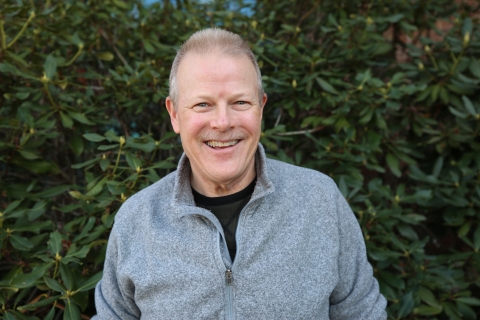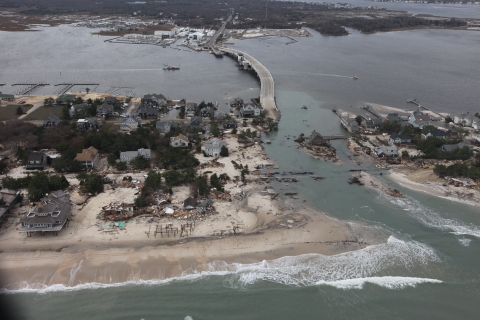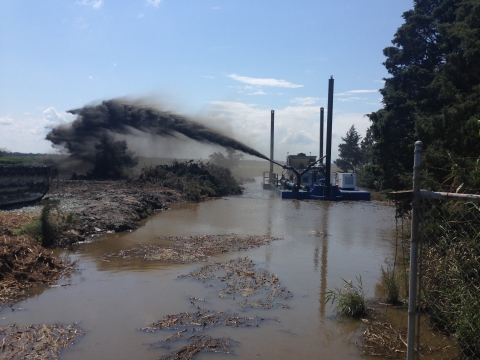Rick Bennett is the type of person who will print out your email so that he can prioritize responding to it. He’s the type of person who will tell you, just in passing, the whole story of how his career began as a fish researcher at a medical school and has evolved through the many facets of restructuring and reorganizing of the U.S. Fish and Wildlife Service, to emphasize the importance of following a passion even down a winding path.
Suffice it to say, Rick Bennett, now the regional scientist in the Northeast Region’s Science Applications program, is the type of person who is thorough and thoughtful, leaving no stone unturned. So when approached by former Regional Director Wendi Weber to lead Hurricane Sandy restoration efforts, Rick Bennett is the type of person who would say “OK, but only if we do it right.”
Saying so was “the best decision I ever made,” Bennett said. “I love the [Sandy] program, and I’ve had a blast doing it. You know, your job should be fun, and mine has been fun—for the most part.”
But the work that Bennett has led through the Sandy program has been far more than fun for the region it’s covered. It has set the standard for restoration efforts across the Northeast, shifting away from returning landscapes to historical conditions and instead focusing on preparation for future conditions. The investment in bolstering resilient landscapes 10 years ago is paying off today as climate change climate change
Climate change includes both global warming driven by human-induced emissions of greenhouse gases and the resulting large-scale shifts in weather patterns. Though there have been previous periods of climatic change, since the mid-20th century humans have had an unprecedented impact on Earth's climate system and caused change on a global scale.
Learn more about climate change and its effects become ever-more prominent.
“One of the things I am really proud of,” Bennett said, “is that all the Sandy projects are seen as [prioritizing] nature-based solutions. Now everyone is turning to Sandy. It is influencing how other operations and other things are going on across the nation.”
Planning for future conditions, 10 years ago
In late October 2012, after striking Jamaica and Cuba, Hurricane Sandy ripped a path up the East Coast. On the 29th, the storm made landfall near Atlantic City, New Jersey, mere miles from Edwin B. Forsythe National Wildlife Refuge. New York, Connecticut, Rhode Island, and Massachusetts all were deluged and saw damage by the storm’s wind and rain.
With $300 million in funding for resilience projects, the Department of the Interior awarded the Service $103 million. This funding was unique, Bennett explained, because it was designated specifically for resilience, in addition to earlier funding designed for recovery from storm damage. He oversaw both pots of funding.
This focus on resilience has offered some of the most important lessons, for Bennett and the Service as a whole, about conservation in a world rocked by climate change: “[One of biggest lessons I’ve learned is to] design to future conditions. Don't design to the past—you're informed by the past, but you design to future conditions.”
While this may seem like a no-brainer now, it’s a line of thinking that’s evolved over the past 10 years, as climate change’s threats have become ever-more present and these Sandy restoration projects have chugged along. “What’s interesting is that [the storm and subsequent restoration were] timed when climate was really just piquing the interest of people,” Bennett observed.
It’s given a framework to think through restorations that prepare a system for climate change.
“We’ve always looked at the historical [conditions]: Where has it been? What has it looked like? Then we would design the restoration to look like that. That was when we were in a pretty stable climate. It’s only in the last 15 years or so that we’ve moved outside of that stable climate period; things are changing. So we need to be informed by the past but look to the future.”
Sustaining Smith Island
Take Maryland’s Smith Island, part of Martin National Wildlife Refuge and the Chesapeake Marshlands Refuge Complex, for instance. It’s one of Bennett’s favorite examples.
There, already-low elevation and a climate-change-induced rising sea-level mean that the island is losing 8-10 feet of marsh to open water every year. It’s a place that Bennett knows we won’t have forever, but he also knew that bolstering against these climate change effects could help extend its life for the people and animals who depend upon it.
“That particular habitat is so unique and so valuable in the Chesapeake Bay. There's nothing else to replace it,” Bennett said. “Sometimes you need to protect things—even though you know you're going to lose them—until you can transition other areas to fill in these [ecological] gaps. That's another piece of resilience. People sometimes just think resilience is transitioning to reach other habitats, but you need to hang on to some until you get [other ecosystems] there.”
So with $9 million in resilience funding, Bennett set out to help the community and managers of Smith Island extend the viability of the little, sinking island by setting in motion plans to construct a living shoreline project—coastal oyster reefs that break and absorb wave energy while still leaving spaces for sediment and animals to pass through to land.
It provides some insight into one of the unique ways Bennett is thinking of resilience work: a way to bolster habitats against climate change, not in perpetuity, but to be a bridge for at-risk species as they adapt to changing conditions and preserve beloved, economically important ecosystems for the people who depend on them.
Smith Island offers a prime example of restoration that benefited people as much as wildlife. The island is home to a thriving Chesapeake waterman community, and local crabbers and residents were actively involved in project planning. As a result, the design honored the culture and direct needs of the surrounding community.
“I can remember talking with a local community member who told me 'If my grand-pappy knew that I was talking to the feds, he’d roll over in his grave,’” Bennett said. “But then he goes, ‘But that was then, and this is now. Now you're our heroes.’ That was amazing.”
“How did we get there? It's because we had a great person [Chesapeake Marshlands Complex Wildlife Biologist Matt Whitbeck] talking to them, working with them, communicating with them, valuing their culture, their heritage.”
The experience has crystalized into one of the biggest lessons Bennett has taken away from this work: communicate early and often, with everyone. And keep people at the center.
Applying these lessons across the Northeast
The lessons at Smith Island and other project locations go beyond abstract takeaways; Bennett’s staunch commitment to monitoring outcomes has been a central feature of his leadership—and has provided data for repeating and improving projects.
“We're putting all this money into resilience. How do we know if we achieve it?” he said. “And you want to know that because then you won't make the same mistakes twice, right? So, if it's not working, why isn't it? And then you can modify. You’re learning as you go; isn't that what science is all about?”
Bennett secured $9.7 million to monitor the performance of Sandy projects. Collecting project-based data ends up comprising around 6% of the project cost, he noted. People complain that it’s expensive (he disagrees), that it’s unglamorous and less flashy, especially compared to spending funds on something visual like oyster reefs or sediment placement; but it’s also crucial, Bennett maintains.
“How else do you know if what you did worked?”
How else, additionally, would you know how to translate these projects to locations across the Northeast, one of the biggest lasting impacts of Bennett’s vision?
“A lot of [new] things in development are because of Sandy, and now we’re trying to apply [those lessons] to everything we do going forward in the region,” Bennett said.
Systems over self
To Bennett, the success of projects and the emulation of projects is true success.
“It’s not about me; it’s about the work and the success of the work. It’s not the success of Rick. It’s the success of a lot of people—but really success is in the outcome of the projects,” Bennett said.
Now 10 years after the storm hit, the Sandy program has become a defining guidepost for resilience work that lets nature lead the way, while preparing places for a future greatly affected by climate change. Bennett can consider himself, his team, and his projects successful.
He still sees the work that lies ahead for the Service. As he looks to retirement on the somewhat-near horizon, he hopes that the lesson he leaves behind—in addition to standards of designing to future conditions and collecting data with every project—is one of systems-driven restoration.
“We may be working on a site for a species—restoring a habitat for saltmarsh sparrows or river herring—but when I am in there, I am working on systems restoration, not for individual species alone,” he said. “If you restore for a system, then everything will follow.”
It’s a fitting legacy for someone who prioritizes the team’s success over his own—while making sure things are done right.







